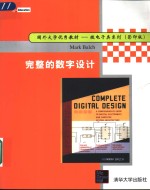

完整的数字设计PDF电子书下载
- 电子书积分:15 积分如何计算积分?
- 作 者:(美)鲍尔奇(Balch,M.)著
- 出 版 社:北京:清华大学出版社
- 出版年份:2004
- ISBN:7302077312
- 页数:460 页
PART 1 Digital Fundamentals 1
Chapter 1 Digital Logic 3
1.1 Boolean Logic 3
1.2 Boolean Manipulation 7
1.3 The Karnaugh map 8
1.4 Binary and Hexadecimal Numbering 10
1.5 Binary Addition 14
1.6 Subtraction and Negative Numbers 15
1.7 Multiplication and Division 17
1.8 Flip-Flops and Latches 18
1.9 Synchronous Logic 21
1.10 Synchronous Timing Analysis 23
1.11 Clock Skew 25
1.12 Clock Jitter 27
1.13 Derived Logical Building Blocks 28
Chapter 2 Integrated Circuits and the 7400 Logic Families 33
2.1 The Integrated Circuit 33
2.2 IC Packaging 38
2.3 The 7400-Series Discrete Logic Family 41
2.4 Applying the 7400 Family to Logic Design 43
2.5 Synchronous Logic Design with the 7400 Family 45
2.6 Common Variants of the 7400 Family 50
2.7 Interpreting a Digital IC Data Shect 51
Chapter 3 Basic Computer Architecture 55
3.1 The Digital Computer 56
3.2 Microprocessor Internals 58
3.3 Subroutines and the Stack 60
3.4 Reset and Interrupts 62
3.5 Implementation of an Eight-Bit Computer 63
3.6 Address Banking 67
3.7 Direct Memory Access 68
3.8 Extending the Microprocessor Bus 70
3.9 Assembly Language and Addressing Modes 72
Chapter 4 Memory 77
4.1 Memory Classifications 77
4.2 EPROM 79
4.3 Flash Memory 81
4.4 EEPROM 85
4.5 Asynchronous SRAM 86
4.6 Asynchronous DRAM 88
4.7 Multiport Memory 92
4.8 The FIFO 94
Chapter 5 Serial Communications 97
5.1 Serial vs.Parallel Communication 98
5.2 The UART 99
5.3 ASCII Data Representation 102
5.4 RS-232 102
5.5 RS-422 107
5.6 Modems and Baud Rate 108
5.7 Network Topologies 109
5.8 Network Data Formats 110
5.9 RS-485 112
5.10 A Simple RS-485 Network 114
5.11 Interchip Serial Communications 117
Chapter 6 Instructive Microprocessors and Microcomputer Elements 121
6.1 Evolution 121
6.2 Motorola 6800 Eight-bit Microprocessor Family 122
6.3 Intel 8051 Microcontroller Family 125
6.4 Microchip PIC? Microcontroller Family 131
6.5 Intel 8086 16-Bit Microprocessor Family 134
6.6 Motorola 68000 16/32-Bit Microprocessor Family 139
PART 2 Advanced Digital Systems 143
7.1 RISC and CISC 145
Chapter 7 Advanced Microprocessor Concepts 145
7.2 Cache Structures 149
7.3 Caches in Practice 154
7.4 Virtual Memory and the MMU 158
7.5 Superpipelined and Superscalar Architectures 161
7.6 Floating-Point Arithmetic 165
7.7 Digital Signal Processors 167
7.8 Performance Metrics 169
Chapter 8 High-Performance Memory Technologies 173
8.1 Synchronous DRAM 173
8.2 Double Data Rate SDRAM 179
8.3 Synchronous SRAM 182
8.4 DDR and QDR SRAM 185
8.5 Content Addressable Memory 188
Chapter 9 Networking 193
9.1 Protocol Layers One and Two 193
9.2 Protocol Layers Three and Four 194
9.3 Physical Media 197
9.4 Channel Coding 198
9.5 8B 1OB Coding 203
9.6 Error Detection 207
9.7 Checksum 208
9.8 Cyclic Redundancy Check 209
9.9 Ethernet 215
Chapter 10 Logic Design and Finite State Machines 221
10.1 Hardware Description Languages 221
10.2 CPU Support Logic 227
10.3 Clock Domain Crossing 233
10.4 Finite State Machines 237
10.5 FSM Bus Control 239
10.6 FSM Optimization 243
10.7 Pipelining 245
11.1 Custom and Programmable Logic 249
Chapter 11 Programmable Logic Devices 249
11.2 GALs and PALs 252
11.3 CPLDs 255
11.4 FPGAs 257
PART 3 Analog Basics for Digital Systems 265
Chapter 12 Electrical Fundamentals 267
12.1 Basic Circuits 267
12.2 Loop and Node Analysis 268
12.3 Resistance Combination 271
12.4 Capacitors 272
12.5 Capacitors as AC Elements 274
12.6 Inductors 276
12.7 Nonideal RLC Models 276
12.8 Frequency Domain Analysis 279
12.9 Lowpass and Highpass Filters 283
12.10 Transformers 288
Chapter 13 Diodes and Transistors 293
13.1 Diodes 293
13.2 Power Circuits with Diodes 296
13.3 Diodes in Digital Applications 298
13.4 Bipolar Junction Transistors 300
13.5 Digital Amplification with the BJT 301
13.6 Logic Functions with the BJT 304
13.7 Field-Effect Transistors 306
13.8 Power FETs and JFETs 309
Chapter 14 Operational Amplifiers 311
14.1 The Ideal Up-amp 311
14.2 Characteristics of Real Op-amps 316
14.3 Bandwidth Limitations 324
14.4 Input Resistance 325
14.5 Summation Amplifier Circuits 328
14.6 Active Filters 331
14.7 Comparators and Hysteresis 333
Chapter 15 Analog Interfaces for Digital Systems 339
15.1 Conversion between Analog and Digital Domains 339
15.2 Sampling Rate and Aliasing 341
15.3 ADC Circuits 345
15.4 DAC Circuits 348
15.5 Filters in Data Conversion Systems 350
PART 4 Digital System Design in Practice 353
Chapter 16 Clock Distribution 355
16.1 Crystal Oscillators and Ceramic Resonators 355
16.2 Low-Skew Clock Buffers 357
16.3 Zero-Delay Buffers:The PLL 360
16.4 Frequency Synthesis 364
16.5 Delay-Locked Loops 366
16.6 Source-Synchronous Clocking 367
Chapter 17 Voltage Regulation and Power Distribution 371
17.1 Voltage Regulation Basics 372
17.2 Thermal Analysis 374
17.3 Zener Diodes and Shunt Regulators 376
17.4 Transistors and Discrete Series Regulators 379
17.5 Linear Regulators 382
17.6 Switching Regulators 386
17.7 Power Distribution 389
17.8 Electrical Integrity 392
Chapter 18 Signal Integrity 397
18.1 Transmission Lines 398
18.2 Termination 403
18.3 Crosstalk 408
18.4 Electromagnetic Interference 410
18.5 Grounding and Electromagnetic Compatibility 413
18.6 Electrostatic Discharge 415
Chapter 19 Designing for Success 419
19.1 Practical Technologies 420
19.2 Printed Circuit Boards 422
19.3 Manually Wired Circuits 425
19.4 Microprocessor Reset 428
19.5 Design for Debug 429
19.6 Boundary Scan 431
19.7 Diagnostic Software 433
19.8 Schematic Capture and Spice 436
19.9 Test Equipment 440
Appendix A Further Education 443
Index 445
- 《指向核心素养 北京十一学校名师教学设计 英语 七年级 上 配人教版》周志英总主编 2019
- 《数字影视特效制作技法解析》王文瑞著 2019
- 《设计十六日 国内外美术院校报考攻略》沈海泯著 2018
- 《计算机辅助平面设计》吴轶博主编 2019
- 《高校转型发展系列教材 素描基础与设计》施猛责任编辑;(中国)魏伏一,徐红 2019
- 《景观艺术设计》林春水,马俊 2019
- 《高等教育双机械基础课程系列教材 高等学校教材 机械设计课程设计手册 第5版》吴宗泽,罗圣国,高志,李威 2018
- 《指向核心素养 北京十一学校名师教学设计 英语 九年级 上 配人教版》周志英总主编 2019
- 《数字插画实战 人像创作30例》王鲁光著 2019
- 《Cinema 4D电商美工与视觉设计案例教程》樊斌 2019
- 《大学计算机实验指导及习题解答》曹成志,宋长龙 2019
- 《指向核心素养 北京十一学校名师教学设计 英语 七年级 上 配人教版》周志英总主编 2019
- 《大学生心理健康与人生发展》王琳责任编辑;(中国)肖宇 2019
- 《大学英语四级考试全真试题 标准模拟 四级》汪开虎主编 2012
- 《大学英语教学的跨文化交际视角研究与创新发展》许丽云,刘枫,尚利明著 2020
- 《北京生态环境保护》《北京环境保护丛书》编委会编著 2018
- 《复旦大学新闻学院教授学术丛书 新闻实务随想录》刘海贵 2019
- 《大学英语综合教程 1》王佃春,骆敏主编 2015
- 《大学物理简明教程 下 第2版》施卫主编 2020
- 《指向核心素养 北京十一学校名师教学设计 英语 九年级 上 配人教版》周志英总主编 2019
